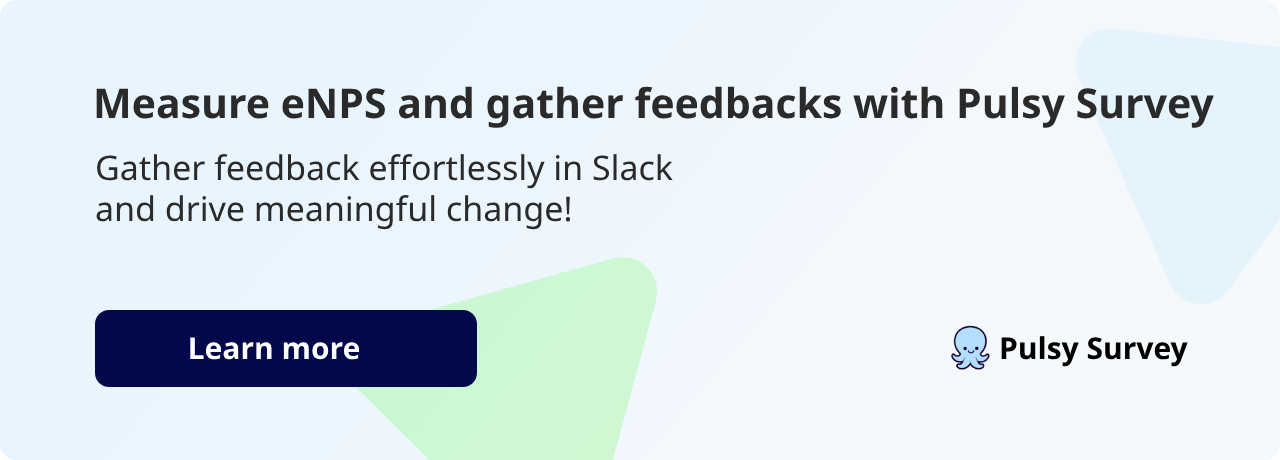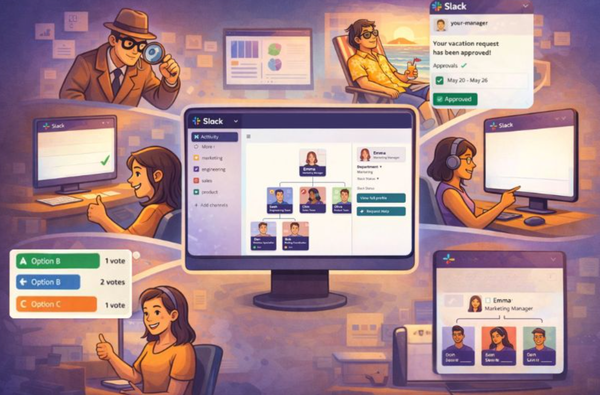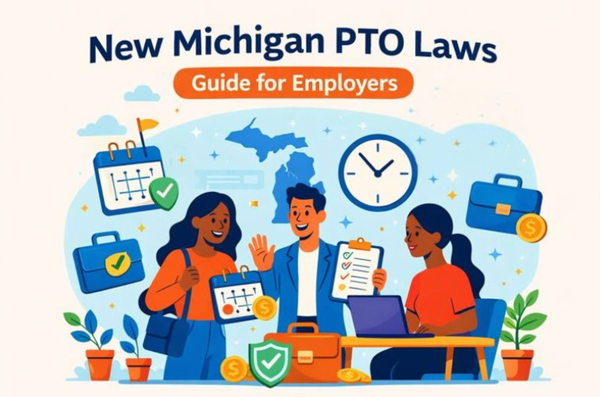How to Collect Anonymous Feedback in Slack
Learn how to effectively collect anonymous feedback in Slack to foster open communication, trust, and continuous improvement within your team.


Anonymous feedback in Slack helps employees share honest opinions without fear. While Slack doesn’t support anonymity natively, tools like Pulsy, Abot, and OpenSay make it easy to collect private feedback. Here's how anonymous feedback benefits teams and how to get started:
- Benefits:
- Encourages open communication and honesty.
- Identifies issues early for faster resolutions.
- Builds trust by valuing employee input.
- Collect data from your workforce to get insights and take better decision
- Tools to Consider:
- Wrenly AI: AI prioritization, secure channels, moderation tools.
- Abot: Easy setup, flexible moderation, budget-friendly.
- OpenSay: Simple messaging, basic features for small teams.
- Steps:
- Install a feedback tool from the Slack App Directory.
- Set up a private feedback channel with clear guidelines.
- Test the system to ensure anonymity and usability.
- Regularly review and act on feedback to show employees their voices matter.
Quick Comparison:
Tool | Features | Best For |
|---|---|---|
Wrenly AI | AI-powered prioritization, secure channels, moderation | Advanced feedback management |
Abot | Flexible moderation, easy integration, free trial | Budget-conscious teams |
OpenSay | Simple anonymous messaging, basic features | Small teams with simple needs |
Anonymous Feedback Messages and Polls for Slack Teams
Selecting Tools for Anonymous Feedback
When setting up anonymous feedback in Slack, picking the right tool is key to making it work smoothly. Several tools on the market offer Slack integration while ensuring user privacy and secure data handling.
Comparing Popular Tools
Here’s a quick look at some widely-used tools and what they bring to the table:
Tool | Features | Ideal For |
|---|---|---|
Wrenly AI | - AI-powered feedback prioritization | Teams needing advanced feedback management |
Abot | - Optional moderation features | Teams looking for flexible, budget-friendly options |
OpenSay | - Simple anonymous messaging | Small teams with straightforward needs |
Wrenly AI stands out for its ability to use AI to identify and prioritize the most critical feedback points [2].
What to Look for in a Tool
When choosing a tool, keep these factors in mind:
- Security and Integration: Go for tools that provide secure, anonymous feedback channels and work seamlessly with Slack. The best options let users share feedback directly within Slack [1][2].
- Moderation and Ease of Use: Features like content moderation help manage inappropriate submissions, while an intuitive interface encourages more team members to participate [2][3].
- Alignment with Your Team: Choose a tool that matches your team’s communication style and values. This makes it easier for everyone to adopt and engage with the system [1].
Picking the right tool ensures feedback stays private, encourages team participation, and helps you gather insights that matter. Once you’ve made your choice, you’ll be ready to integrate it into Slack and start collecting feedback.
Guide to Setting Up Anonymous Feedback in Slack
Installing the Feedback Tool
To get started, look for tools like Wrenly AI or Abot in the Slack App Directory. Click "Add to Slack" and follow the steps to integrate the tool. Keep in mind, you'll need admin permissions to complete the setup.
For instance, Wrenly AI simplifies the process with built-in security and moderation features. The setup typically involves granting permissions, creating a feedback channel, and adjusting privacy settings to maintain anonymity.
After installation, the next step is to set up a dedicated space for feedback within Slack.
Setting Up an Anonymous Feedback Channel
Create a private channel and outline clear guidelines for its use. Make sure the channel is configured to protect anonymity. Use prompts that encourage open discussion, such as:
"What areas could our team improve on?" or "How do you feel about the progress of our current project?"
These types of questions help keep feedback aligned with team goals and encourage meaningful input [1].
To make the most of anonymous feedback tools, it’s important to acknowledge and act on the feedback you receive [2].
Before rolling out your feedback system, double-check the following:
- Messages are fully anonymized.
- Feedback submissions remain anonymous, and responses are accessible without any technical issues.
- The process for submitting feedback is straightforward for users.
Once everything is in place, test the system thoroughly to ensure anonymity is preserved and the tool works as intended before launching it to your team.
Best Practices for Collecting Anonymous Feedback
Keeping Feedback Anonymous and Secure
When using Slack for anonymous feedback, prioritize privacy. Make sure your feedback tool is set up to block any user tracking, and conduct regular checks to confirm privacy settings are up to date.
For added security, consider third-party tools that automatically remove identifying details from submissions. Once you're confident anonymity is protected, explain the system's purpose clearly to encourage employees to participate.
Communicating the Purpose of Feedback
A clear explanation of the feedback system's purpose encourages more engagement. When rolling out an anonymous feedback process, share key details like:
- How the feedback will be used: Explain how it will guide improvements or influence decisions.
- Who will access the feedback: Be transparent about who will review the input.
- Review and action timeline: Let employees know when feedback will be reviewed and when changes might happen.
Setting these expectations helps build trust and ensures employees feel their input is valued.
Acting on Feedback
Create a structured approach for handling feedback effectively:
Phase | Action |
|---|---|
Collection | Regularly monitor feedback channels to address urgent concerns. |
Analysis | Look for patterns or recurring themes that need attention. |
Response | Share summarized insights and outline planned actions. |
Implementation | Put changes into place based on suggestions from the feedback. |
When responding to feedback, keep submissions anonymous while acknowledging the input. Regularly update employees on changes made as a result of their feedback to demonstrate its impact and value [1][2].
Incorporating Anonymous Feedback into Workplace Culture
Building Trust with Feedback
Trust grows when anonymous feedback channels are consistently used, and employees see their input leading to real changes. Tools integrated with platforms like Slack can make regular pulse surveys easy, encouraging open communication.
When workers notice their anonymous suggestions driving improvements, they become more engaged in the process. This creates a positive cycle of participation, leading to better insights and a more connected workplace.
Enhancing Engagement and Culture
Anonymous feedback can reveal workplace issues that might otherwise go unnoticed. Organizations can use this input to:
- Spot communication breakdowns and improve how information is shared
- Adjust policies to better support work-life balance
- Tackle sensitive topics like diversity and inclusion
To get the most from anonymous feedback, consider these steps:
- Set Up Specific Feedback Channels: Create Slack channels dedicated to different feedback types. Ensure anonymity while allowing for focused discussions and tracking changes over time.
- Commit to Regular Reviews: Schedule consistent feedback reviews to maintain momentum and show employees their input matters.
- Highlight Success Stories: Share examples of changes made based on feedback. This reinforces the process's value and motivates ongoing participation.
Slack-integrated tools designed for feedback make the process simple and accessible. Features that promote constructive feedback help maintain quality while encouraging ongoing improvement [4].
Conclusion: Using Anonymous Feedback to Improve Communication and Culture
Anonymous feedback tools in Slack play a key role in building trust and openness. They allow employees to share their thoughts freely, which helps spark ideas and boost engagement - two essentials for creating a thriving workplace environment [1].
These tools not only keep feedback anonymous but also make the process of gathering input straightforward. With Slack integration, it’s easy for teams to participate regularly, ensuring feedback becomes a natural part of the workflow.
Here’s how to make the most of anonymous feedback:
- Pick the Right Tools: Opt for platforms with strong moderation options and smooth Slack integration [2].
- Set Clear Plans: Define actionable steps to turn feedback into meaningful changes.
- Respond Promptly: Show your team you value their input by addressing feedback quickly.
When these practices are part of everyday operations, organizations can create an environment that prioritizes trust and ongoing improvement.
Studies show that anonymity leads to more honest and impactful feedback. By setting up regular feedback cycles and tracking participation and engagement, companies can use this insight to strengthen their culture.
To keep the momentum, tools like Pulsy from BuddiesHR can be a helpful addition. They offer structured surveys to monitor progress and ensure employee engagement initiatives stay on track.
Regularly analyzing feedback trends helps maintain an effective system that continues to improve communication and workplace culture.
FAQs
Can you do anonymous surveys or send anonymous feedback in Slack?
Yes, but you'll need third-party tools since Slack doesn't support anonymity by default [1]. Tools like Simple Poll, Abot, and Wrenly AI can help you run anonymous surveys and collect feedback securely.
Here’s a quick guide to using these tools:
- Install the tool from the Slack App Directory.
- Turn on anonymous settings for your workspace.
- Set up specific channels for collecting feedback.
- Use the tool’s commands (like
/Wrenly) to submit feedback. - Check responses in private channels set up for this purpose.
For detailed instructions, check out the earlier sections of this guide.
Important tips for using anonymous feedback tools:
- Double-check your privacy settings to ensure anonymity.
- Stick to workplace communication policies.
- Actively review and respond to feedback.
- Use private channels to keep feedback confidential.
These tools are designed to protect anonymity, but it’s important to ensure all feedback promotes a positive and constructive environment.




